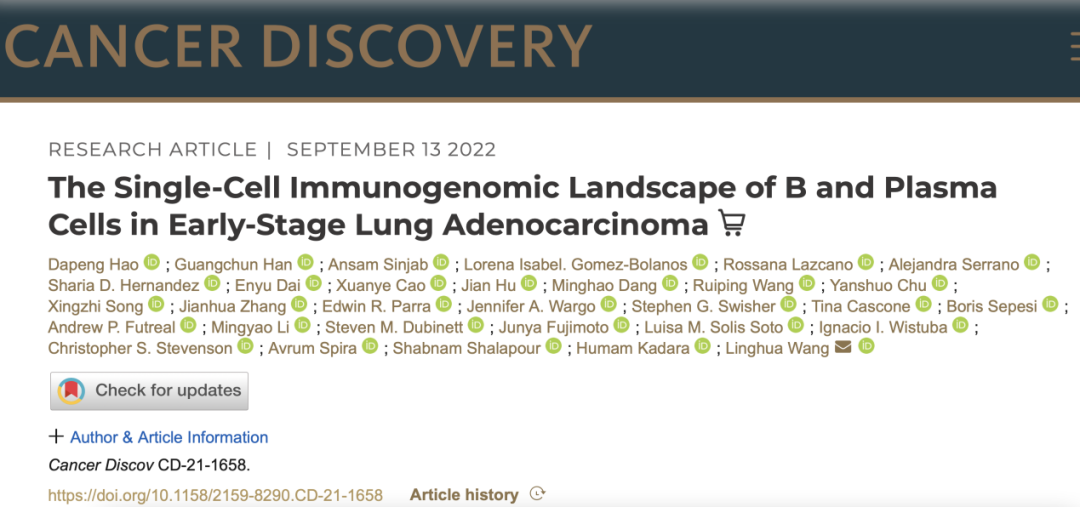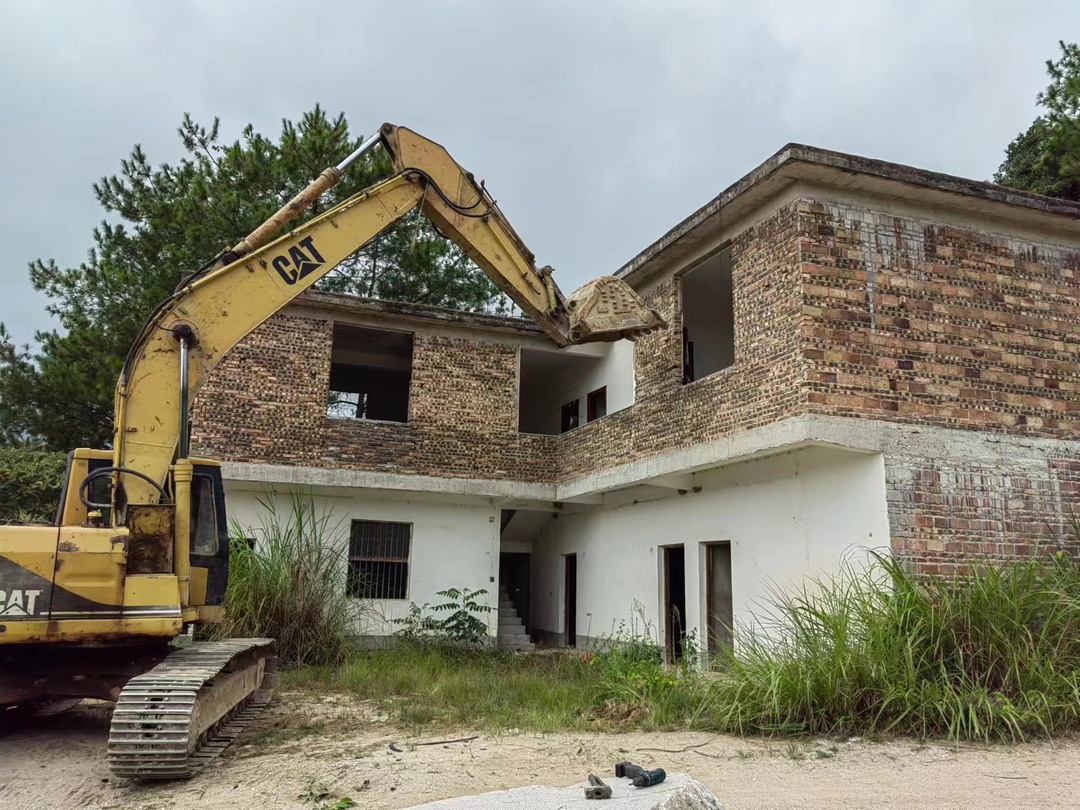Wang Linghua team describes the B cells and plasma cell maps in early lung cancer in detail at the level of single cells
Author:Bioart biological art Time:2022.09.20

#cancer#
LUAD (LUAD) is the most common subtype of lung cancer tissue. The 5 -year survival rate of 5 years after surgery is less than 50%. Once the tumor occurs remote metastasis, the 5 -year survival rate will drop to 7%. A reasonable application of early treatment solutions requires a deep understanding of tumor immune microevacom. Tumor-Infiltration B and Plasma Cells (TIBS) infiltrated with tumor-infiltrated can affect the reactions and prognosis of chemotherapy and immunotherapy [1,2], but existing single-cell research lacks the onset of TIBS in physical tumors in physical tumors. In -depth analysis of surface and status in the mechanism.
2022年9月13日,德克萨斯大学MD安德森癌症中心的王淩华团队和Humam Kadara团队合作在Cancer Discovery在线发表题为The Single-Cell Immunogenomic Landscape of B and Plasma Cells in Early-Stage Lung Adenocarcinoma Article. The work of TIBS from different spaces in different spaces in patients with early pulmonary adenocarcinoma and cell differentiation status, BCR immunomotive component Claoon amplification and diversity, immunoglobulin model conversion, high -frequency mutation (SHM), TIBS space, TIBS space, TIBS space The distribution and the interaction of the tumor immunochemical comprehension have comprehensively analyzed the characteristics of TIBS in lung cancer, and reveal their potential role in the development of early lung adenocarcinoma. The study has constructed the largest and most comprehensive TIBS transcription group and immune group library map. A breakthrough discovery that can be transformed into clinical rapid transformation in this study is that the pulp cells in lung cancer can be used as potential biomarkers to predict the survival time of patients with lung cancer and to immunotherapy.

Researchers collected 47 samples of cancer samples from different space positions from tumors and three kinds of distances from the tumor site, and detected SCRNA-SEQ and SCBCR-SEQ data. After strict data quality control, 49,062 TIBS single -cell data was obtained, which is by far the largest single -cell data set in TIBS in the early LUAD. This work identifies 12 TIBS sub -groups, including Naive B, Plasmablast, Stressed Plasma, 2 Memory B Cell sub -groups, and 7 pastey groups.
The TIBS content in LUAD is very rich, but the relative composition shows greater heterogeneity. Naive B -cells gradually decreased as the distance from the tumor tissue, and Memory B Cell and the abundance of the pulp cells have become higher. This increased phenomenon is more significant in smoking patients than non -smoking patients. The study also found that higher pulp cells infiltration is related to good pathological staging, general survival, no progressive survival, and immune examination point blocking treatment reactions. There are samples of EGFR mutations. The content of pulp cells is only about 1/3 of the wild samples, which may have a lot to do with the low reaction rate of immunotherapy with EGFR mutations [3]. Most of the TIBS detected in LUADS is positioned in the area where lymphocyte aggregates, and it is also a potential three -stage lymph structure. The large increase in CXCL13+ T cells in tumor immunochemicals may promote the recruitment of B cells, and it may also lead to the heterogeneity of TIBS phenotypes in the Luad tumor immunocus. The production of CXCL13 may originate from a variety of cells. In addition to TFH cells, a large number of T cells that express CXCL13 in the tumor environment, including exhaustive T cells and regulatory T cells.
By further exploring the differentiation state of B Cell, it is found that the pulled cells show a long-live state in the tumor sample of patients with smoking. At the same time, the IGA of the Memory B Cell in the tumor has a significant expression compared to the tissue tissue of the cancer, indicating that it may come from the advanced phase of the birth center. Through in -depth analysis of the characteristics of the BCR immune group library, it is found that the tumor -specific cloning dilatation is low, the clone diversity is high, and it is more obvious among smoking patients. Compared to the cancer, the B cell antibody category in the tumor tissue is more frequent, and a unique V (d) j retactions may occur. In addition, the frequency of B -cell SHM gradually changes with the distance between the tumor, and the closer to the tumor position, the easier it is to change.
Finally, the researchers explored the role of TIBS's immune regulation. The significant expression of TGFB1 in cancer -related fibroblast space areas may be related to the high IgA+ PCS content in LUADS. The expression of multiple immunomasical genes is rich in Memory B Cells and IgA+ PCS, and IgA+ PCS is co -existed with TREG, CD8+ Tex, CAFS, and macrophages with activation and proliferation, which is negatively related to toxic lymphocytes, indicating that They may have the function of suppressing immunity. This potential immunosuppressive and tumor -promoting role require further functional research to confirm.

Pattern
In summary, this work deeply explores the role of TIBS's phenotype heterogeneousness in the progress of early lung adenocarcinoma and immune pathology, and provides valuable ideas for the development of new immunotherapy strategies. Professor Wang Linghua of the MD Anderson Cancer Center and Professor Humam Kadara communicate the author of this article. The first author Dr. Hao Dapeng is currently working at the Basic Medical College of Harbin Medical University.
【Introduction to the author of the communication】
Wang Linghua (https://faculty.mdanderson.org/profiles/linghua_wang.html), an associate professor of the U.S. Anderson Cancer Center. Teacher Wang Linghua has rich professional knowledge in computing biology, immune oncology, and cancer immunogenic genome, and has formed a comprehensive laboratory based on computing biology research. Laboratory application innovative biological information methods have in -depth analysis of tumor cells and tumor microe environmental cells to identify the inherent and micro -ring factors of tumor cells that drive tumor phenotypes and evolved in tumor cells. Get a series of breakthrough results. Related work published in Nature (2014, 2020), Nature Medicine (2020, 2021), Cancer Discovery (2021,2022), Lancet Oncology (2022), Nature Genetics (2019, 202020), Gut (2019, 202020) ), Nature Communications (2021-2022, n = 5), Science Translational Medicine (2019) and other magazines. Teacher Wang's team fund is sufficient, recruiting postdoctoral and computational scientists for a long time.
See the following links for the recruitment details:
https://mdanderson.referrals.selectminds.com/jobs/sr- computational-scientist-genomic-medicine-48346?et=5a1jphocn
https://jobs.mdanderson.org/search/jobdetails/postdoctorary-fellow/c6bfcd2c-253E-4814-AF2F-FD98107414be
【Introduction to the First Author】
Hao Dapeng obtained a bachelor's degree in physics engineering, a master's degree in biology, and a doctorate degree in biomedicine, and has been engaged in research on epigenetic information and cancer biological information at Belle Medical College and the MD Anderson Cancer Center of Belle Medical College and the MD Anderson Cancer Center. He was selected as a national youth talent plan project in 2021 and joined the Basic Medical College of Harbin Medical University as a doctoral supervisor. The research team is currently committed to the analysis of genetic transcription regulation, tumor immunity, and tumor multi -group learning big data. It is a typical multidisciplinary cross -research laboratory. The research group recently carried out a number of related topics based on single -cell technology and spatial transcription groups. At the same time, it is also conducting relevant experiments on tumor immunology and cancer transcription regulation. Welcome to more excellent talents (postdoctoral, technicians, and graduate students) to join the team to jointly join the team. Promoting the progress of topics.
For more information, please refer to the laboratory website:
https://haobioolab.github.io/we%20are%20Recuiting/
Original link:
https://doi.org/10.1158/2159-8290.cd-21-1658
references
1. Helmink ba, redddy sm, gao j, et al. B cells and tertiary laymphoid structures promote Immunotherapy response. Nature 2020; 577 (7791): 549-55.. 549-55.
2. Sinjab A, Han G, Treekitkarnmongkol W, et al. Resolving the spatial and cellular architecture of lung adenocarcinoma by multiregion single-cell sequencing. Cancer Discov 2021;11(10):2506-23 doi 10.1158/2159-8290.CD -20-1285.
3. K hastings, h a yu, wwei, et al. EGFR Mutation Subtypes and Response to Immune Checkpoint Blockade Treatment in Non-Small LUNG CANGER. Ann OnCol.: 10.1093/Annonc/MDZ141. If you want to know more exciting content, come and pay attention to bioart biological art


- END -
The core area of the West Lake Ecological Park Landscape Engineering is planned to be open New Year's Day next year
The Herald reporter was informed on the 7th that 34 public construction projects in the West Lake Ecological Park area that received much attention. Except for the West Lake Ecological Park landscape
Hongshan Town, Yongding District launched an illegal occupation of forest land rectification actions

Hongshan Town, Yongding District launched an illegal occupation of forest land rec...